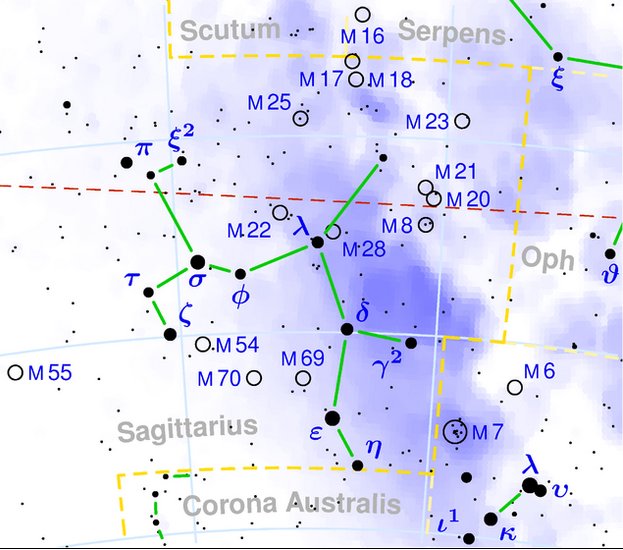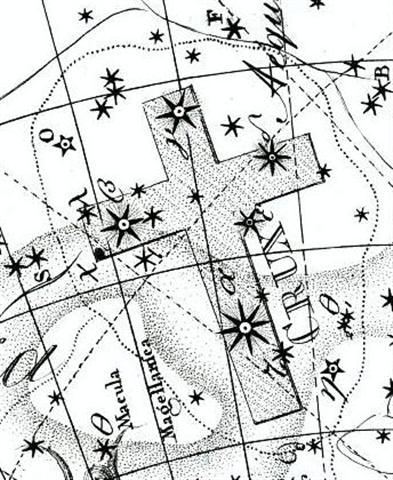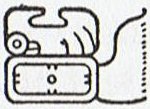The text on
side a ends at a time which can be coordinated with the heliacal
stars in A.D. 1582, when the Pope Gregory XIII introduced
his updated version of the Julian calendar:
... Gregory dropped 10 days to bring the calendar
back into synchronisation with the seasons. Accordingly, when
the new calendar was put in use, the error accumulated in the 13
centuries since the Council of Nicaea was corrected by a
deletion of ten days. The Julian calendar day Thursday, 4
October 1582 was followed by the first day of the Gregorian
calendar, Friday, 15 October 1582 (the cycle of weekdays was not
affected) ...
|
NOVEMBER
1 |
2 (306) |
3 (*227) |
4 |
5 |
 |
 |
 |
 |
 |
|
Ga8-22 |
Ga8-23 |
Ga8-24
(227) |
Ga8-25 |
Ga8-26 |
|
19h
(289.2) |
Al
Baldah-19 |
ALADFAR
= η Lyrae
(291.1),
NODUS II
= δ Draconis
(291.5), ψ Sagittarii (291.6), τ Draconis (291.7), θ
Lyrae (291.8) |
ω
Aquilae (292.1), ρ Sagittarii (292.6), υ Sagittarii
(292.7) |
π
Draconis,
ARKAB
PRIOR = β¹ Sagittarii
(293.0),
ARKAB
POSTERIOR = β² Sagittarii, ALRAMI = α Sagittarii
(293.2),
χ Sagittarii
(293.6) |
|
λ
Aquilae (Ant.) (289.1), γ Cor. Austr (289.3),
τ Sagittarii
(289.4), ι Lyrae (289.5), δ Cor. Austr. (289.8)
|
AL
BALDAH = π Sagittarii,
ALPHEKKA MERIDIANA = α Cor. Austr.
(290.1), β Cor. Austr. (290.2) |
|
January 4 |
5 (*290) |
6 |
7 (372) |
8 |
|
°December 31 |
°January
1 |
2 (*287) |
3 (368) |
4 |
|
'December 8 |
9 |
10
(*264) |
11 (345) |
12 |
|
"November 24 |
25 (329) |
26
(*250) |
27 |
28 |
|
NAKSHATRA DATES: |
|
MAY 3
(123) |
4 |
5 (*45) |
6 (*411) |
7 (492) |
|
WEZEN =
δ Canis Majoris
(107.1), τ Gemini (107.7), δ Monocerotis (107.9) |
no star listed (108) |
λ Gemini (109.4),
WASAT = δ Gemini
(109.8) |
no star listed (110) |
ALUDRA = η Canis Majoris
(111.1),
PROPUS = ι Gemini
(111.4),
GOMEISA = β Canis Minoris
(111.6) |
|
July 6
(*107) |
7 |
8 |
9 (190) |
10 |
|
°July 2 |
3 (184) |
4 |
5 |
6 (*107) |
|
'June 9 |
10 (161) |
11 |
12 |
13 (*84) |
|
"May 26 |
27 |
28 (148) |
29 |
30 (*70) |
In rongorongo times, however, which according
to my interpretations was approximately another 4 precessional days
later, the star π (Al Baldah) - marking the 'corner' in Sagittarius
- was at the
Sun in January 5 (i.e. 290 days after 0h).

|
Egyptian
sebchet |
 |
Phoenician
pe |
 |
Greek
pi |
Π (π) |
|
Wikipedia: '...
according to a theory by Theodor Nöldeke from 1904,
some of the letter names were changed in Phoenician
from the Proto-Canaanite script ...
pit 'corner' to
pe 'mouth' ...'
However, I think
the Egyptian source hieroglyph could have been
Gardiner's O14 (sebchet), a sign which
illustrates a corner with feather-like ornaments
upon the walls. The meaning was 'portal'
according to Wilkinson. Or why not an Archway
for exit, the Mayas had a 'grasping hand' (Chikin)
in the west:
To be in a corner
means there is no way forward.
|
Curiously the haú type of glyph looks
like a mixture between Phoenician pe and Egyptian
sebchet, especially if we should look at pe from
the opposite side (i.e. if we should read the text from
right to left in Arab fashion):
In 1582 A.D., which was 260 years earlier than
my preferred year for rongorongo,
there was evidently no important star rising with the Sun at
0h. But close to the Full Moon and at the opposite side of
the sky was Acrux and the other stars of the Southern
Cross - as if a reminder of Gregory's role as Pope for the
Christianity:
|
1842 A.D. |
1582 A.D. |
76 B.C. |
1070 B.C. |
2703 B.C |
|
Sirrah |
°Acrux |
'Sheratan |
"Bharani |
AIN |
|
0 |
3 |
27 (= 3 + 24) |
41 (= 27 + 14) |
64 (= 27 + 37) |
|
® |

|
JANUARY 19 (384) |
20 (*305) |
21 |
22 |
 |
 |
 |
 |
|
Gb7-1 |
Gb7-2 (183) |
Gb7-3 |
Gb7-4 (414) |
|
σ Andromedae
(3.0), ι Ceti
(3.3), ζ Tucanae
(3.5),
ρ Andromedae,
π Tucanae (3.7) |
no star listed
(4) |
ANKAA = α
Phoenicis,
κ Phoenicis
(5.0)
ALPHARD (α
Hydrae) |
λ Phoenicis
(6.3), β Tucanae
(6.4) |
|
March 24 (83) |
EQUINOX |
26 (*370) |
27 (451) |
|
°March 20 (79) |
21 (0h) |
22 (*366) |
23 (447) |
|
'February 25 |
26 (57) |
27 (*343) |
28 (424) |
|
"February 11 |
12 (43) |
13 (*329) |
14 |
|
NAKSHATRA DATES: |
|
JULY 21 |
7-22 (*123) |
23 |
24 (205) |
|
Chang Sha
(186.3) |
INTROMETIDA = ε
Crucis
(187.4),
ACRUX
= α Crucis
(187.5) |
γ Com. Berenicis
(188.0), σ
Centauri
(188.1),
ALGORAB = δ
Corvi
(188.5),
GACRUX = γ
Crucis
(188.7)
|
γ Muscae
(189.0),
AVIS SATYRA = η
Corvi
(189.3),
ASTERION = β
Canum Ven.
(189.5),
KRAZ = β Corvi,
κ Draconis
(189.7 |
|
September 23
(*186) |
24 |
25 (268) |
26 |
|
°September 19 |
20 (*183) |
21 (264) |
EQUINOX |
|
'August 27 |
28 (340) |
29 |
30 (*162) |
|
"August 13 |
14 (326) |
15 |
16 (*148) |
...
Ecclesiastically, the
equinox is reckoned to
be on 21 March (even
though the equinox
occurs, astronomically
speaking, on 20 March in
most years)
....
When Julius Caesar
established his calendar
in 45 BC he set March 25
as the spring equinox
...
Gregory XIII
changed the Julian date for spring
equinox with 4 days - which
also 'happened to be' the precessional
distance from Gregory up to the time of
rongorongo. Could they on Easter Island
have maintained
March 25 as the date for the
equinox? I have
chosen, in my table above, to distinguish
between 0h and the Julian
idea of the time for the
northern spring equinox.
At the time of Gregory XIII
it was day 183 after 0h when
Acrux rose with the Sun. And
at the end of side a on the G
tablet the Full
Moon reached day 107 after
0h:
|
NOVEMBER 1 |
2 (306) |
3 (*227) |
4 |
5 |
 |
 |
 |
 |
 |
|
Ga8-22 |
Ga8-23 |
Ga8-24 (227) |
Ga8-25 |
Ga8-26 |
|
19h (289.2) |
Al Baldah-19 |
ALADFAR = η Lyrae
(291.1),
NODUS II = δ Draconis
(291.5), ψ Sagittarii (291.6), τ Draconis
(291.7), θ Lyrae (291.8) |
ω Aquilae (292.1),
ρ Sagittarii
(292.6), υ Sagittarii (292.7) |
π Draconis,
ARKAB PRIOR = β¹ Sagittarii
(293.0),
ARKAB POSTERIOR = β² Sagittarii, ALRAMI = α
Sagittarii
(293.2),
χ Sagittarii
(293.6) |
|
λ Aquilae (Ant.)
(289.1), γ Cor. Austr (289.3),
τ Sagittarii
(289.4), ι Lyrae (289.5), δ Cor. Austr.
(289.8) |
AL BALDAH = π Sagittarii,
ALPHEKKA MERIDIANA = α Cor. Austr.
(290.1), β Cor. Austr. (290.2) |
|
January 4 |
5 (*290) |
6 |
7 (372) |
8 |
|
°December 31 |
°January 1 |
2 (*287) |
3 (368) |
4 |
|
'December 8 |
9 |
10 (*264) |
11 (345) |
12 |
|
"November 24 |
25 (329) |
26 (*250) |
27 |
28 |
|
NAKSHATRA DATES: |
|
MAY 3 (123) |
4 |
5 (*45) |
6 (*411) |
7 (492) |
|
WEZEN = δ Canis Majoris
(107.1), τ Gemini (107.7), δ Monocerotis
(107.9) |
no star listed
(108) |
λ Gemini
(109.4),
WASAT = δ Gemini
(109.8) |
no star listed
(110) |
ALUDRA = η Canis Majoris
(111.1),
PROPUS = ι Gemini
(111.4),
GOMEISA = β Canis Minoris
(111.6) |
|
July 6 (*107) |
7 |
8 |
9 (190) |
10 |
|
°July 2 |
3 (184) |
4 |
5 |
6 (*107) |
|
'June 9 |
10 (161) |
11 |
12 |
13 (*84) |
|
"May 26 |
27 |
28 (148) |
29 |
30 (*70) |
From
ρ Andromedae
(together with θ and σ at her right arm) to Alrami (α
in the Archer) there were 293 - 3 = 290 days,
which might explain why 29 was an important measure
in the rongorongo texts. °March 20 (3-20) was the
astronomically correct date for spring equinox.
|
Sumerian SAG |
 |
Phoenician resh |
 |
Greek rho |
Ρ (ρ) |
|
...
Resh (Arabic: rāۥ)
is the twentieth letter of many
Semitic alphabets, including
Phoenician, Aramaic, Hebrew ... The
word resh is usually assumed
to have come from a pictogram of a
head, ultimately reflecting
Proto-Semitic *raۥ(i)š-.
The word's East Semitic cognate,
rēš-, was one possible phonetic
reading of the Sumerian cuneiform
sign for 'head' (SAG).

.jpg) |


|









.jpg)

